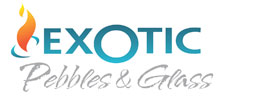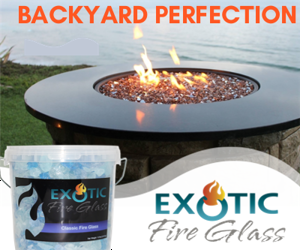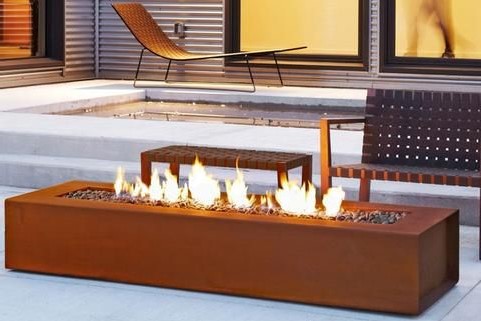
Fire pit rings, when to use and which one? To sum up this article, always use h frame burners for your fire feature, whenever possible. Why, how and how big? Well read on and find out.
Check out our full collection of fire pit ring accessories here.
A week ago I helped a client refine his back yard, a small pergola, a rocky spring, some flagstone on rubber mulch bedding. Classic stuff until it came to the background fire features. In-wall burners over some dark burgundy fire glass. And the client was surprised by my choice in burners. He just used fire pit rings until then, because the fire was always a round centerpiece. This means a fire pit ring made the most sense.
The second issue was the size. I got a big 30 incher. I always go for the biggest possible because we rarely work with hard reflexive surfaces and we use fires as radiant assets even when in the background. And he had a small yard, small for anything outside of a city, so there are some exceptions when space is limited. Anyway, despite his doubts, the set up was perfect, the extra length of the fire. Spread a wide beam of light onto the area, casting soft shadows that wrapped around everything.
I could have put it a bit higher to be honest because the walls around it allowed for some more volume to play with. But’ volume is another story I’ll cover in a whole post. Until then you can read eco glass, small yards and patio guide about how patio furniture and separators change our perception of available space, but those were more about creating more visible space and this was about using more space, lighting it up and using higher elements to bring it all down to the garden.
GAS FIRES AND FIRE PIT RINGS
Fire features come in a wide variety: fireplaces, fire pits or table fires. And for most of them, we use gas burners because they are cleaner, safer and more versatile. Among the range of burners, you will find a wide variety but they fall under linear or round fire pit rings. All other variations are either designer one-offs that you buy from a manufacturer to fit a very specific scene. Or are manufacturer specific proprietary designs made to sell you the same thing at a higher price or sometimes less in terms of build quality and materials used.
For all but the most niche of designs, you will either use a round flame or a linear-flame and that can be done by these 2 types of burners. A last note on other proprietary designs, you will see some linear burners that all this guide can apply to, but won’t in practice unless you use 2 side by side. A single line of flame lacks enough volume to create a visual impact. It ends up looking like a burning leaves or Kindle instead of a roaring log fire.
You will see in the examples below. Also, some of those linear gas elements are really fragile and I don’t like fragile when dealing with fire. Always check for a warranty and look around for the manufacturer’s reputation. So keep in mind that all the linear fires can and should be replaced with shorter, wider fires as a general rule.
FIRE PIT RING BY SHAPE
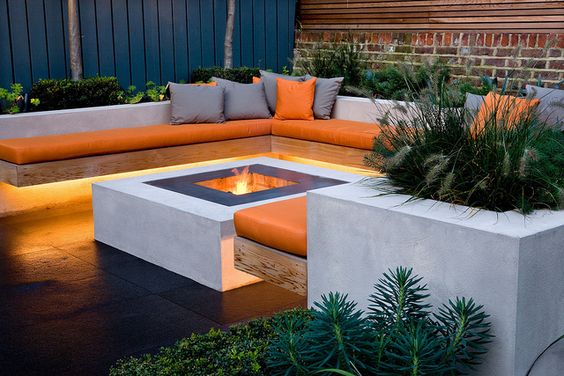 But back on track with the do’s instead of the don’t’s. We think of the landscaping environment in terms of scenes and frames of view. We are deconstructing the design in 2D pictures that we can see at any given time. That’s the human limitation, expanded 3D with depth only conceptually we compose a 3D environment in our heads. I want you to try this next time you see a movie, especially a good one. Think of what the camera is showing you, and why it isn’t showing you something else, a close up on someone’s face or a wide angle showing their whole body going from one part to the other.
But back on track with the do’s instead of the don’t’s. We think of the landscaping environment in terms of scenes and frames of view. We are deconstructing the design in 2D pictures that we can see at any given time. That’s the human limitation, expanded 3D with depth only conceptually we compose a 3D environment in our heads. I want you to try this next time you see a movie, especially a good one. Think of what the camera is showing you, and why it isn’t showing you something else, a close up on someone’s face or a wide angle showing their whole body going from one part to the other.
Art is about not showing more than showing. By not showing you allow the viewer to concentrate on what’s left instead of processing everything. So in terms of gas burners, that means that all fires, only have 2 dimensions at any given time and depth becomes irrelevant after 6 to 10 inches. That means you have only height and with to really play with. Situationally you want to use height and create a large unified fire, that’s when you use fire pit rings, and always the biggest one you can fit. In all other cases, you go with an H burner and think of it as a light source first then as a stand-alone feature.
FIRE PIT RING SIZE
Size is a little more complicated because we are dealing with it as a light source rather than a feature inches does not always correlate with effect. You can find a technical guide. Technical aspects aside, let’s assume you can make the space for the fire from scratch, any size you want, what size should you make it?
Well, the short answer as I said it as big as you can make it, within limits. Around 28 inches, above that, it’s situational and think about using 2 smaller elements for a more 3D effect. Shaping the light around elements and having softer shadows. That’s why pop-up flashes on cameras make for hard features and bad pictures. There is only one source of light so every shape and contour gets a dark shadow wrapped around it. This makes everything but the most naturally gorgeous men look angular and distorted. But it does wonders if you have an edge chiseled jaw and diamond cheekbones.
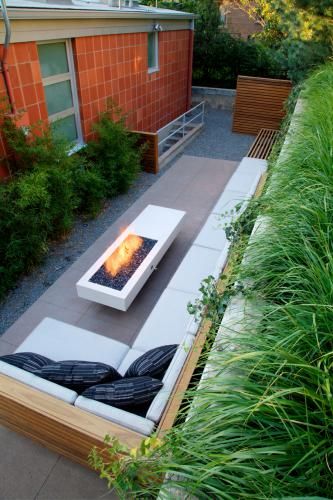
Vanity mirror lighting has the opposite effect, a lot of light sources reduce shadows almost completely. The shadow cast by each light gets lit by the other lights that are at a slightly different angle. This softens features and especially pores. It’s like electrical real life photoshop. The same thing happens with side lighting or wall to wall lights. You get a soft glow all around the garden giving it warmth hue instead of lighting it up.
Obviously, there are stylistic caveats. Use single lights when you want that darker jungle-feel you get from the shadows of each large leaf. And you want to have a dark area. This works extremely well in combination with vertical water features as the sound gets amplified by the darkness. The glimmer and movement of the water really brings tension to a dark scene. Something most people ignore when the light up their waterfall.
WHEN TO GO SMALL WITH FIRE PIT RINGS
Usually, the simplest gas fire pit is in table fire pits. You need a table anyway and adding another element just for the fire doesn’t look good. Here is where you use the small 12-inch burner. At this size, it doesn’t matter if you use a fire pit ring or h burner, and it’s a matter of personal tastes. For classical traditional uses go for a fire pit ring, the round fire also is more versatile being more of a “classic fire”. Most no fuss timid tables or fire bowls are round so in that case, it does works slightly better.
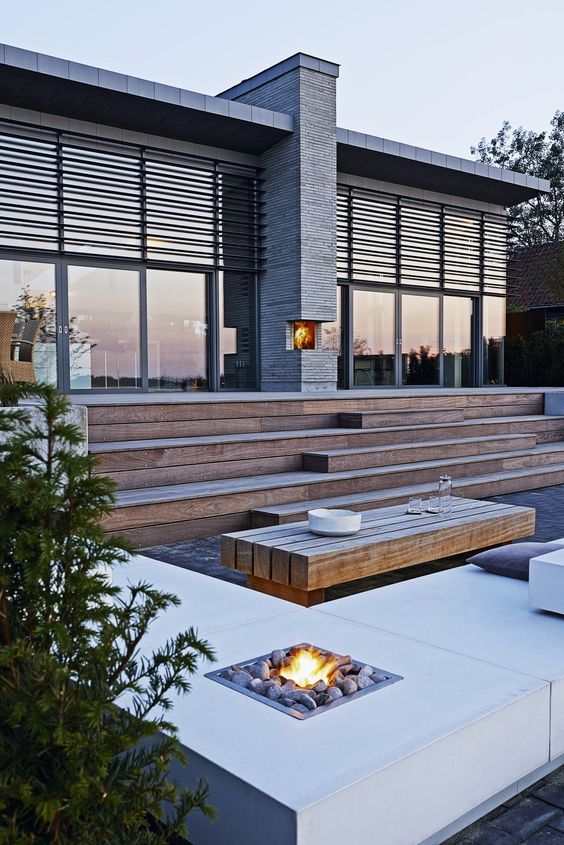
I say only slightly because a flame is fluid, it will not only follow any objects in its path flowing over them grabbing their shape, but it will also bunch up and end in a conical peak. The differences are negligible, so just go with the fire pit ring. In this particular case, the most important thing is: how small can you get it.
It’s gonna be right in the line of sight of people at night and as mesmerizing as a fireplace can be, that’s just tiresome. Because it’s this obvious, go very restrained. I prefer lava rock as a rule of thumb. It’s non-reflexive and the broodiness of it makes it a great counterpoint to the lively fire.
In larger scenes feel free to include them in empty bland spots as light sources that add a warm glow all around. Small fires are excellent as permanent candles. Consider a large element that has layers to it, like a fake wall. Building fireplaces inside it creates the illusion of a living entity like the concrete had a roaring fire in it all along.
Corners on minimalist clean spaces are also very vulnerable to looking empty and neglected. A small fire or a downscale version of that like a lamp post with a hanging lantern should cover the space and make it a source of vibrancy instead of a black hole. When using small fire assets be careful of their background, especially if it’s a broody dark gray minimalist scene. The fire will look accidental, underwhelming in small sizes. And larger fires are out of the question because they would spoil the mood. Add some glimmer either dark tonal but shiny fire glass or light pale but matte.
WHEN TO GO ROUND AND USE FIRE PIT RINGS
This is debatable, but usually, in the ground fire pits work better with large fire pit rings. Looking down at the fire, you can clearly see the edges of an H burner fire, so if you are looking down at the fire, always use a fire pit ring if you want to maintain that feeling of a round natural fire. And an important note, the correlation of round fire pit and round fire works both ways. That’s why you usually do round fire pits anywhere down low to the ground. I’m talking about classic settings of course because you can have some designer modern features like a fire row or long fire pit, which not only doesn’t try to look like a round fire but is intentionally linear and acts as a shape in the grand design.
Another situation would be if you have intentionally circular seating all around the fire. Like 4 semi-circular seats with gaps around it. There’s a lot of reasons why you should never completely surround an element and open the space up so it can breathe, but I’ve covered that here. If you do want to keep it closed down for the privacy effect or to make it feel more intimate and isolated then that’s one case where a fire rig is a must, and I recommend a really large one as looking down at the fire makes it feel smaller relatively to your position.
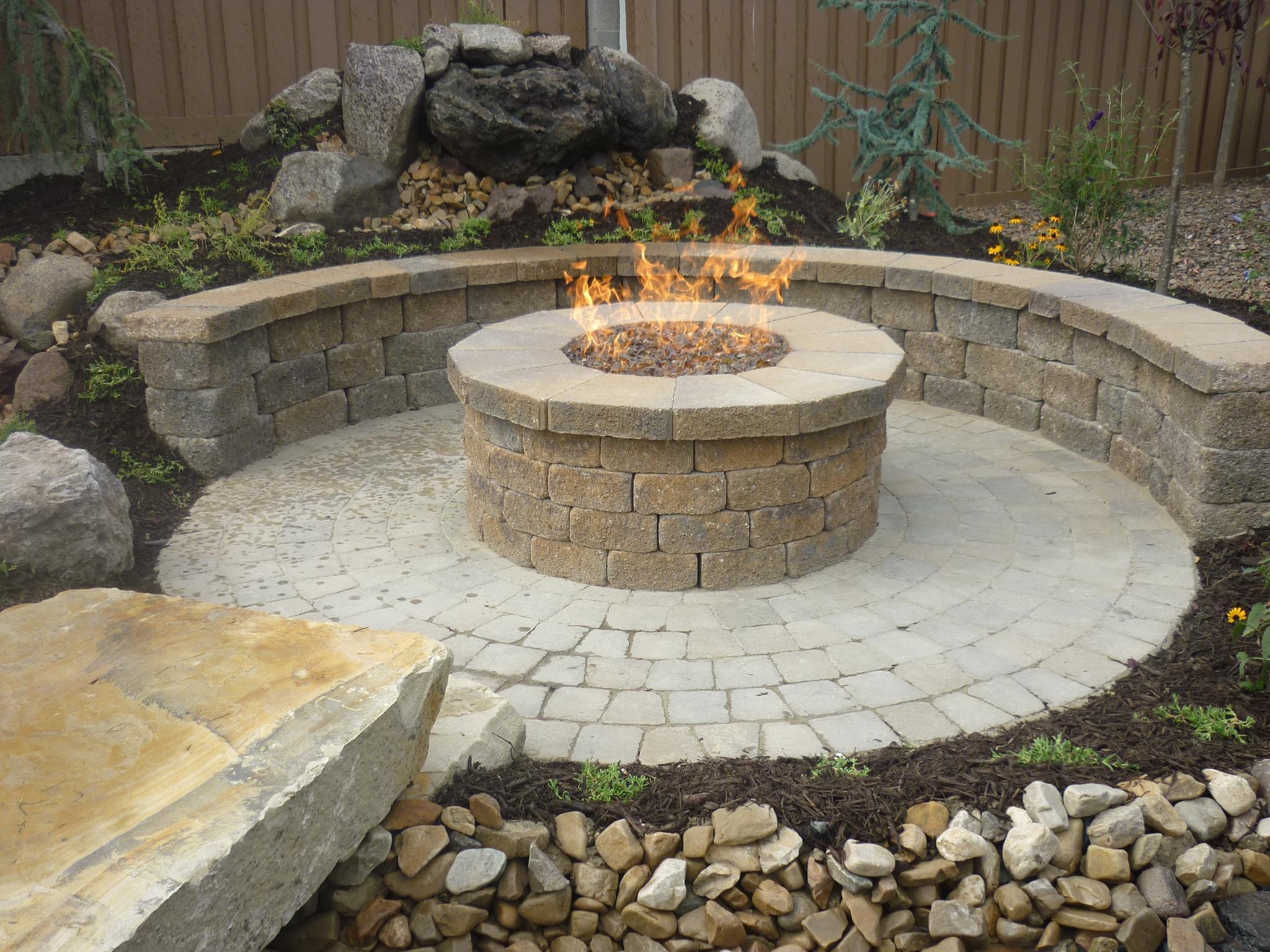
WHEN TO GO LONG?
Long flames are probably the only ones worth going custom if you want flames longer than 40 or 50 inches. But even then, I would think of a double solution. That flame is going to be very large and it will turn night into day, ruining the atmospheric vibe you usually get from a fire lit area. Long flames are usually thin and underwhelming or very large and bright. It takes a lot of tweaking over different seasons for even me to get this right. It’s a real balancing act and unless you really want that long continuous line of fire, never try this. You have enough things to maintain and manage as it is in a garden. Features and centerpieces should not be one of them.
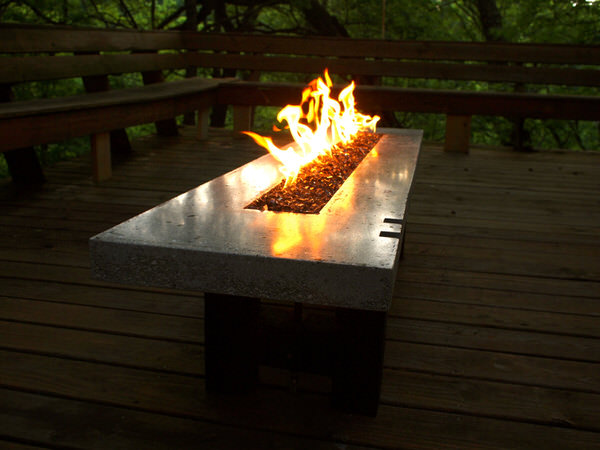
Now unlike real life landscaping, the design industry from photographers to editors love these and you will see them in a lot of photoshoots. They just look so good in pictures, that oblique long line of fire frozen in time just gives moment and vibe to a scene. But keep in mind that you can and more likely should deconstruct the picture and downscale it to fit your needs. And a 30-inch H burner is usually more than you need because you will never be understated while they very rarely underperform.
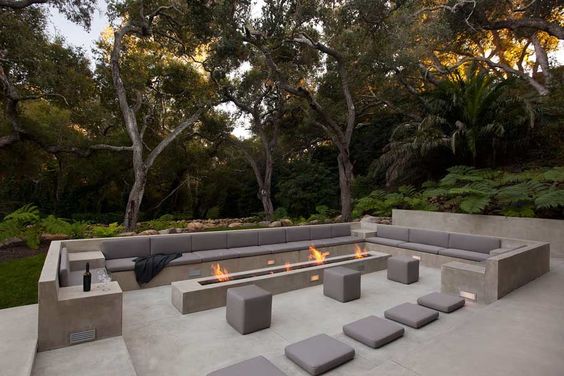 In fact, I am willing to guarantee that your yard is so large that a 30-inch is too small, you are not doing your own design and have hired a professional designer to do it for you. And sells you on something long and weak that would look great in their portfolio.
In fact, I am willing to guarantee that your yard is so large that a 30-inch is too small, you are not doing your own design and have hired a professional designer to do it for you. And sells you on something long and weak that would look great in their portfolio.
Before you ok that, Consider a row of candles, because it’s a very strong element that you can’t see how well it will work before it’s actually in place. A variation is the discontinued line of small fires. Or in the case of a wall to wall in wall fire, there is an even better variation. Having the wall segmented and 5 to 7 smaller fires spread around at different heights and but at the same distance from one another.
I give you that a horizontal wall break is a great looking was to break the monotony of the wall and the light coming from a long fiery line is very cool and atmospheric. But this “patched up” design does all that and is unique and interesting. The whole wall becomes a feature and a mild light source for the rest of the scene. If your wall happens to be out of natural stone, the “stochastic design” works exponentially better than just a simple line.
H BURNERS
Now that we covered the exceptions let’s sink into the H burner. Essentially, it is an H frame through which natural gas or propane flows, creating 2 long lines that have nozzles where the gas can burn out off. This creates two walls of flame for a thick flame and a lot of character with the strong edges. Left alone, it’s harsh and looks industrial at best. But if you cover it with just some fire glass and shape the flames, giving them something to bounce off of, it comes into its own.
Always go for the 30 inches. And make everything else adapt. Whether it’s a fire bowl or a fireplace. You can’t be subtle about it. You have a fire feature, show it off and make everything else a visual accessory. As for fireplaces specifically, use large faux logs or other hard large glass to give it enough personality to stand on its own against the hardscape of the fireplace. A small flame inside a granite fireplace is just, depressing.
Now, back to fire pits, where the H burners shine. In most tables, bowls and or stations, the H burner will create a larger visible fire, even with a smaller installation. It’s literally the biggest effect with the smallest space investment. Think of that linear fire I talked about above. Segmenting the pit into 4 elements and nestling 4 h burners would have given you a thicker flame, constantly and with no hassle and I would argue that over that length some segmentation would have made the table more interesting.
I’ll give you that it wouldn’t be as stunning. But that length is not used well, so the impression goes out fast, leaving you with an underwhelming but very expensive fire feature. The alternative is to save money and use creativity to get the same impact, but make it sustainable, both in terms of costs and maintenance.
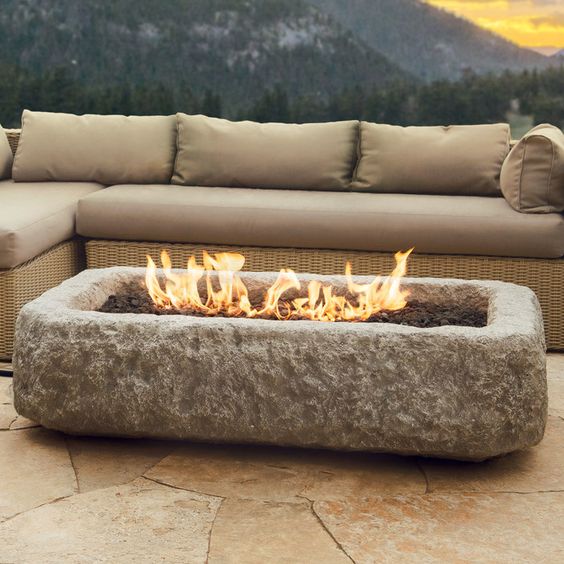 For example, Use a very roughed concrete rectangular bowl. As gritty as possible. Age it with stain and fill it up with lava rock. Use 1 or 2 H burners, depending on how long the stone bowl is. The thick primitive flame coming out of the rock will make an outstanding impression and even the blandest of scenes will turn into an eye-catching scene. That’s why I love concrete so much, it’s cheap and so versatile that your imagination is the only limit. But back to my point, tell me that isn’t impressive and it doesn’t stay with you. The fire feels alive, coming for you. And this is scalable. Apply the rule of threes and use 3 of them. You created a whole theme.
For example, Use a very roughed concrete rectangular bowl. As gritty as possible. Age it with stain and fill it up with lava rock. Use 1 or 2 H burners, depending on how long the stone bowl is. The thick primitive flame coming out of the rock will make an outstanding impression and even the blandest of scenes will turn into an eye-catching scene. That’s why I love concrete so much, it’s cheap and so versatile that your imagination is the only limit. But back to my point, tell me that isn’t impressive and it doesn’t stay with you. The fire feels alive, coming for you. And this is scalable. Apply the rule of threes and use 3 of them. You created a whole theme.
You can go the other way, into the future, still with concrete, create an angular layered table, with asymmetrical features. Stain the dried concrete with coal and give it a gray metal feel and maybe even add a glossy sealant. Cover the H burner with some light fire glass for a futuristic counterpoint or dark glass for a darker look and fewer highlights. Use a granite countertop for a more expensive upgraded version. A version that will fit in any modern broody setting and will give more character than the simple longer is a better gimmick.
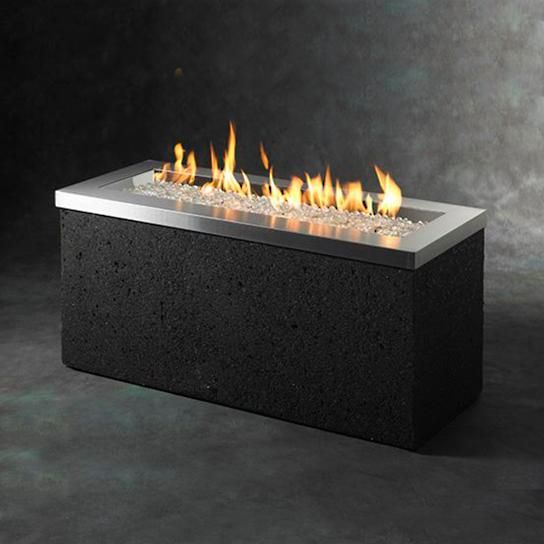 A more low-key version of that same effect can be achieved just by keeping the table as simple as possible. Use the single slab trick. One solid slab of perfectly symmetrical concrete placed around a layered, complex area. This simple concrete slab works because it creates a solid foundation from which both it’s flame and the fire glass under those flames and the area surrounding it can dance around visually around it. First the rest of the setting, it’s a small space, complex tones and there’s a lot of background stuff. The scene is layered and you have both layered decks and a stone pit. That’s a lot for just one corner. But you anchor it all around the central slab at a macro level. The simple shape calms everything down and gives focus.
A more low-key version of that same effect can be achieved just by keeping the table as simple as possible. Use the single slab trick. One solid slab of perfectly symmetrical concrete placed around a layered, complex area. This simple concrete slab works because it creates a solid foundation from which both it’s flame and the fire glass under those flames and the area surrounding it can dance around visually around it. First the rest of the setting, it’s a small space, complex tones and there’s a lot of background stuff. The scene is layered and you have both layered decks and a stone pit. That’s a lot for just one corner. But you anchor it all around the central slab at a macro level. The simple shape calms everything down and gives focus.
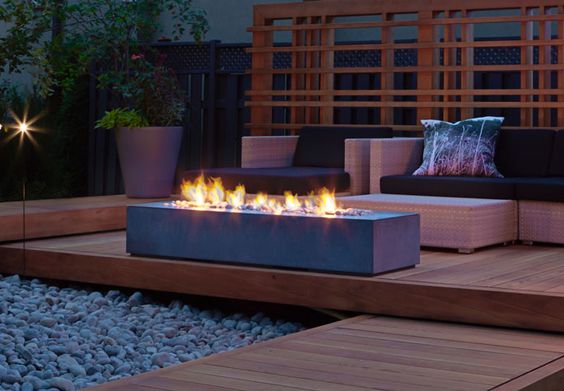 On a micro level, the same thing happens with the fire. Again it’s slim and long but look at the great contrast between hard surface, rough glass, and liquid flames. That’s an exquisite piece right there. 3 textures in one asset fused perfectly together. Here you see the playfulness of the designer in how they play with texture and create interesting spins on simple minimalist features. After that, you notice the pillow on the bland couch or the natural shrub in the simple clean gray planter. Even the deck and rocks make sense now because we understand the cheeky intent in bringing a twist to pure fundamentals.
On a micro level, the same thing happens with the fire. Again it’s slim and long but look at the great contrast between hard surface, rough glass, and liquid flames. That’s an exquisite piece right there. 3 textures in one asset fused perfectly together. Here you see the playfulness of the designer in how they play with texture and create interesting spins on simple minimalist features. After that, you notice the pillow on the bland couch or the natural shrub in the simple clean gray planter. Even the deck and rocks make sense now because we understand the cheeky intent in bringing a twist to pure fundamentals.
 Turning that on its head we have this brown burning box. Wood with modern shapes in a modern light minimal patio. The stones inside it make it busy and heavy.
Turning that on its head we have this brown burning box. Wood with modern shapes in a modern light minimal patio. The stones inside it make it busy and heavy.
Too much personality and individualism compared to the rest of the scene that has simple clean assets. But then you light it up. The flame adds another dimension, the table isn’t just furniture, it’s an event. It’s a dancer that infuses the clinical scene with life and vibrancy. Under the warm light, busy fire table and minimalist patio fuse and complement each other. Warmth spilling over and surprisingly it calms down the features of the table. The dark stones make sense as a source for the primeval fire, while the modern wood-like look of the table becomes a modern holster for the primeval stones and fire, it makes sense it’s not as abstract as everything else.
H BURNER FIREPLACES
The bigger brother to the fire table is the fireplace. And here the H burner is king. Because you only see it from its broadside all the softer edges of the fire ring are negated. All you see when you look at a fireplace is depth and length. Both main advantages of the H burner. An H burners with makes the fire seem solid tangible and powerful. And within the confines of a fireplace you get to focus all that energy. Here things are simplest, natural strong elements. It’s not a design element its cauldron encasing one of nature’s forces. I’ve made a whole post about fireplaces, so check it out for a more detailed breakdown.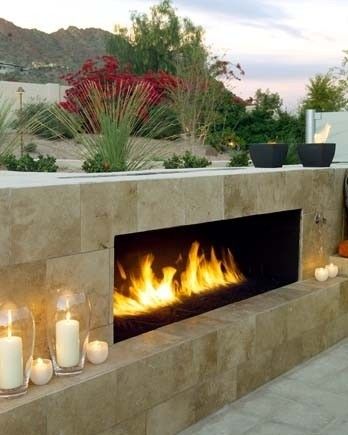
Another particular feature of the fireplace is that it’s unidirectional. So the light you would get from an open fire of the same size is usually cut by 2 thirds or more. This means you get that great moving firecrest with minimal light spillage. This makes it usable in both party patios and on chilly summer nights. The lack of light spill also means this is a great way to get cozy intimate settings with a fire feature apart from 40+ candles. Spread all around your romantic scene. Or why not use both?
FIERY HORIZONS
The next level is a scenic fire. Using fire as an interesting frame through which the people inside the scene see the view, the garden or landscape. This is very hard to pull off and sometimes in more dynamic spaces, not worth it. Think of a terrace where the lights of the city are barely flickering.
A large bright fire just blinds you. But when you do it just right, when you get that combination of a side view, small linear fire and the secondary light opposite of the fire. The view is magical. The effect hypnotizing. It’s obviously very situational and if you can’t pull it off, don’t worry, you don’t need to move to Monaco. Next, I’ll show you how to get a permanent effect on a smaller budget. Well, small compared to going to Monaco.
But before that let’s learn something from the scene.
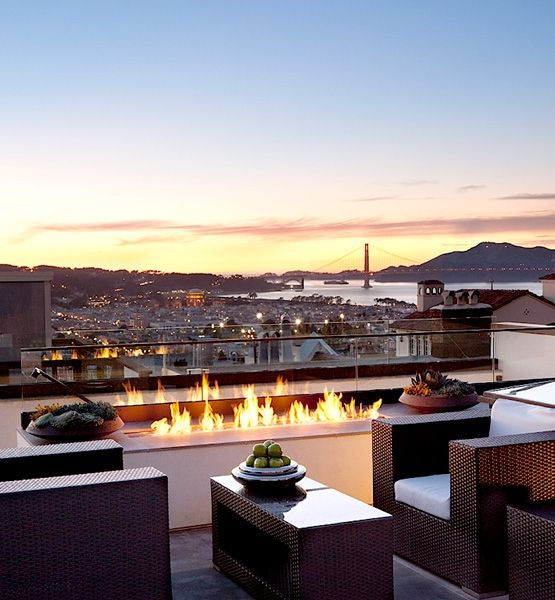 The fire while strong doesn’t overshadow the scene, the city is close by and the patio is well lit. The furniture takes a back seat to the fire and landscape. This makes the fire and the landscape the highlights of the scene, but they don’t compete.
The fire while strong doesn’t overshadow the scene, the city is close by and the patio is well lit. The furniture takes a back seat to the fire and landscape. This makes the fire and the landscape the highlights of the scene, but they don’t compete.
They both take a back seat to the function of the area. It’s a small area, so the designer used intimacy as a feature and designed the area to be an intimate setting for 2 people, crushing the attention seeking landscape and lively fire. Thus, relegated to secondary features the landscape and the fiery frame has no choice but to work together and assist the environment in its human-centered function.
This is an excellent example of function crushing obvious highlights. The landscape is still there. The fire just makes it even more “loud”. But instead of just giving us the obvious, the designer made it submit to the purpose of the location and complement it graciously.
FIERY COUNTERPOINTS
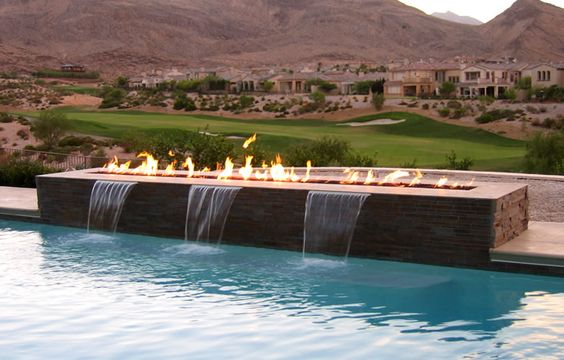 This has been used a lot, and not to its full potential. Similarly to the previous tableau we had. The pool is a functional space. Nothing you put around can take that away from it. So going overboard with a large fire, you just add to it aesthetically. If you happen to have a view right next to it.
This has been used a lot, and not to its full potential. Similarly to the previous tableau we had. The pool is a functional space. Nothing you put around can take that away from it. So going overboard with a large fire, you just add to it aesthetically. If you happen to have a view right next to it.
Well, you have one of the best designs out there, and obviously, I could not mention the waterfall, always have a waterfall. It’s like fire in reverse. It falls where fire rises, it splashes where a fire crackles. It’s elemental in motion. Adding movement and life to something still and practical. Dry and solid become natural and rich just by running water over them.
Now, something I want everyone to notice is that the materials used aren’t anything to break the bank for. The richness comes from the scenery and bold design choices. The fire is a thing and only hinting at flame edges under the scenery.
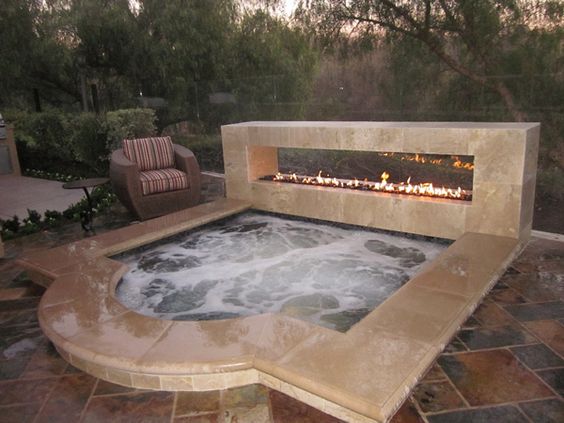 But I can see this is intentional, there’s not a lot of light on this side of the back yard. So instead of filling it in with lights and having a larger fire, they made the fire smaller. I would make it full strength and put a lip around it so only the glow of the tips of the flames actually light the pool directly. And maybe put some greenery behind it to reflect the light and add depth and movement during the night. But then you risk it competing with the view.
But I can see this is intentional, there’s not a lot of light on this side of the back yard. So instead of filling it in with lights and having a larger fire, they made the fire smaller. I would make it full strength and put a lip around it so only the glow of the tips of the flames actually light the pool directly. And maybe put some greenery behind it to reflect the light and add depth and movement during the night. But then you risk it competing with the view.
Another opulent counterpoint that is more accessible would be the spa fireplace. This is what I was talking about before. From the jacuzzi only the lip of the fire is visible. And because of it’s open back most of the light falls softly onto the canopy behind. Creating dancing movements and shadows in the night, without making a day out of the night for the people in the yard. For this example, I would have clearly place larger H burners behind the wall and maybe slot them into it in a more traditional fireplace style keeping the open back. This would have allowed me to have more control over what comes into the garden, as we’ve covered with the advantages of how directional fireplace light is and I would have kept the “dancing background.”
